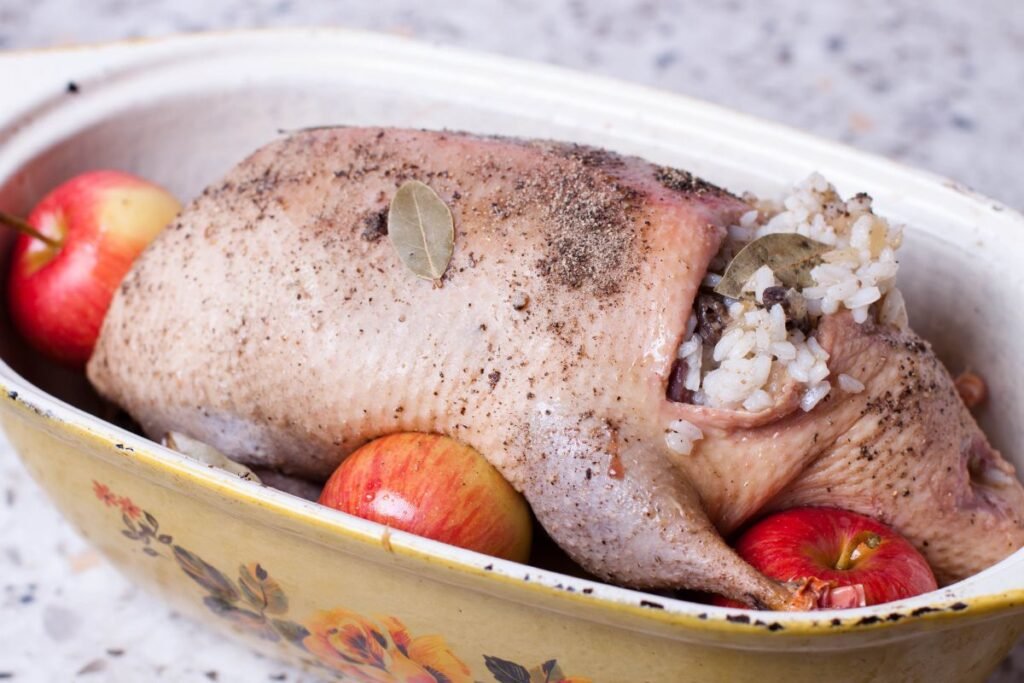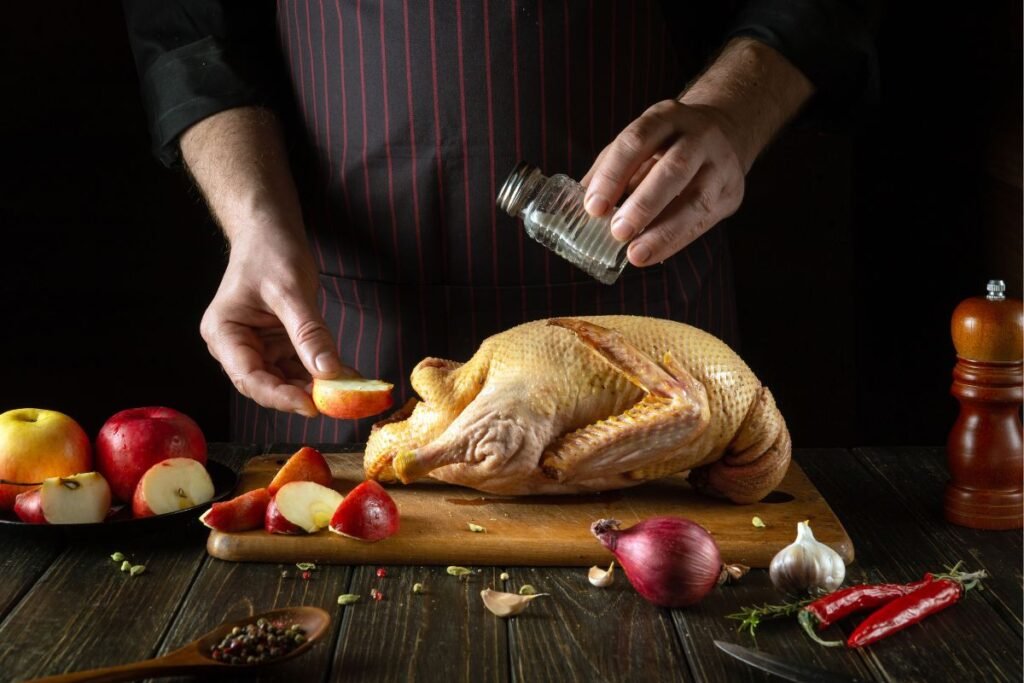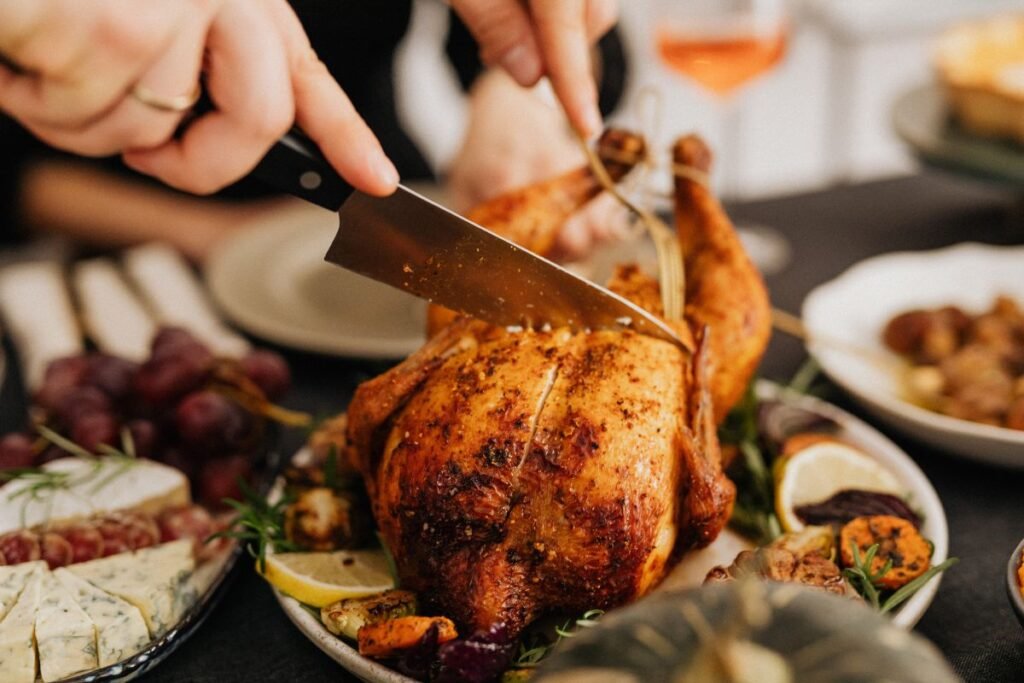Roasted duck is a great choice for a special lunch or dinner. Some people are afraid to cook duck because it is much tougher than chicken or turkey. However, when cooked properly, duck‘s fat slowly melts and moisturizes the meat.
To make a duck really tasty and juicy, you need to put in some effort and know a few tricks. So we want to share a few tips to make your roasted duck especially aromatic, rich in flavor, and simply melt in your mouth.
How to choose a duck?
To ensure the quality of the meat, it is best to choose a duck from a reliable farmer who can accurately indicate the breed and sex of the bird. Meat breeds of ducks, such as Peking, Rouen, Swedish Blue, Saxony, etc., are ideal for roasting. These breeds have a rounder shape, shorter necks and legs than those bred for laying eggs.
Ducks of the Mulard breed – a hybrid of a Muscovy duck and a domestic duck – are also often sold. They are valued for their rapid growth, calm disposition and adequate fat content. It is better to choose female mulards for frying, as males are often raised and fed with specific feed to make their livers fattier. They make an exceptional pâté.
It is also important to choose a young bird. A bird weighing 2 to 2.5 kg, but no more than 3 kg, is considered ideal. The meat of a young duck will be softer, juicier and have a pleasant taste, while older birds often have a strong taste that not everyone likes.
You will need about 500–600 g of raw duck per person, as some of the fat will melt during cooking and the bird will shrink. A 3 kg duck with stuffing and side dishes is perfect for 5–6 people, but if you like to eat more, you can share such a duck among four people.
How to prepare a duck for roasting?
To make a roast duck really delicious, it is important to prepare it properly before cooking.
Washing and drying. Start by washing the bird thoroughly, both inside and out. Then gently pat dry with paper towels. Avoid rubbing to prevent the towels from tearing and sticking to the skin.
Removing the caudal gland. A duck has a small gland in its tail called the caudal gland. It secretes an oily substance that the bird uses to coat its feathers to make them water and cold resistant. When plucked, this gland appears as a small bump on the top of the tail, near the back. Although not everyone removes this gland, we recommend to do so. If you leave the gland in, it can cause a bitter taste when cooking the bird, especially in the lower part. Carefully cut out the gland with a small knife, cutting all the way to the bone.
Removing feather remnants. Carefully inspect the duck and remove any remaining feathers. It is convenient to use tweezers for this – they will allow you to easily pluck out even the smallest feather remnants.
Removing excess fat. On the back of the duck, near the opening to the inside, there are often folds of skin where a lot of fat has accumulated. Trim this fat with scissors, carefully tear it off with your fingers or cut it off a little, trying not to damage the skin, as it will hold the stuffing. Some butchers have already removed excess fat, but it is worth checking. If the duck is very fatty or you plan to roast it in foil or a baking sleeve, it is worth removing as much visible fat as possible. If necessary, you can also cut off the fatty tip of the tail.
Skin incision. It is important to cut the skin of the duck breast across and lengthwise to create a diamond pattern. Cut not only the skin, but also the layer of fat underneath, trying not to damage the muscle. It is best to do this with the knife tilted at a 45° angle – this makes the cut easier to control. To ensure that the fat melts well during cooking, the skin of the breast can be carefully pierced without damaging the muscle. Pierce densely, every couple of centimeters, although this may take time, but will give a better result.
Boiling the duck. If the bird is large (over 3 kg), it is recommended to prepare it according to the steps listed above, and then the duck should be briefly boiled – put it in boiling water and boil for 15-20 minutes. Cool, marinate and only then fry. Boiling helps to remove excess fat, and tougher meat becomes softer and juicier.
Preparing frozen duck
If you bought frozen duck, remove it from its packaging and place it in a bowl. Leave it in the refrigerator to thaw slowly, overnight or longer, depending on the size of the bird. Store it on the higher shelves of the refrigerator to speed up the process. Slow defrosting in the refrigerator helps preserve flavor and ensures safety, as raw poultry should not be kept at room temperature for more than 2 hours. You can prepare thawed duck in the same way as fresh.

Roasted duck – how to marinate?
Use various spices to duck before roasting. Rub the bird with a spice mixture and leave to marinate for at least a few hours in the refrigerator. Salt, black pepper, cloves, cardamom, cinnamon, sweet paprika, garlic and various herbs are perfect for this.
If the duck is large, belongs to the mallard breed or is wild (hunted), we recommend to marinate it in a liquid marinade overnight. This will help soften the meat and give it a more pleasant taste. Such marinating is also suitable for meat ducks, but a few hours are usually enough for them. Mustard, honey, soy sauce, fruit juice, wine are suitable for this.
Brining is a very effective way to marinate a duck, especially if it is large, a mallard or wild duck. A meat duck marinated in brine also becomes very tender and juicy, bringing out its flavor. To prepare the brine, place the duck in a large pot or bowl and pour water over it to determine the amount of water needed. Then remove the duck and gradually add salt to the water, stirring until it dissolves. The proportions are 50–60 g of salt per liter of water.
What to stuff a roast duck with?
Roasted duck has a specific taste, so choose apples, citrus fruits, cranberries, dried apricots or prunes for stuffing it. You also can stuff the duck with various mixtures of offal, for example, boiled rice mixed with minced liver (duck or chicken), hearts, and ventricles. If you stuff ithe duck with sauerkraut, it will soften the meat even more.

Roasted duck stuffed with apples and dried cranberries (recipe)
Duck is often stuffed with apples, which go particularly well with it. During baking, the apples release juices that penetrate the duck meat, softening it and enriching it with a delicate sweet-sour taste and pleasant aroma. More acidic apples are best suited for this dish.
You will need:
- 2-2.5 kg duck
For the marinade:
- 10 cloves of garlic
- 2 tbsp. lemon juice
- 2 tbsp. honey
- 1 tbsp. oil
- 1 tbsp. salt (or to taste)
- 2 tbsp. cinnamon
- 1 tbsp. red sweet paprika powder
- 1 tbsp. pepper
For the filling:
- 2 medium-sized sour apples
- 1 tbsp. dried thyme or other favorite herbs
- 50 g dried cranberries
- 1 tbsp. cinnamon
- 1 sprig of fresh rosemary or thyme

Directions:
- Wash the duck, pat dry with paper towels. Cut off the posterior gland and excess fat from the underside.
- Make diamond-shaped cuts in the skin and fat of the duck breast, without damaging the meat. Prick the skin of the thighs.
- Mix the honey (heat it if it is hard) with the oil, lemon juice, squeezed garlic, sweet paprika, cinnamon, salt and pepper. Rub this mixture well both outside and inside the duck. Leave to marinate in the refrigerator for a few hours.
- Remove the duck from the refrigerator 1-2 hours before cooking to warm it to room temperature.
- Turn on the oven to heat to 220 °C.
- Cut the apples into large slices, remove the seeds. Mix with dried cranberries, dried thyme and cinnamon.
- Stuff the duck with the apple filling, add a sprig of rosemary or thyme, tie the duck legs with thread. If you have chosen to put a lot of stuffing, firstly sew the duck’s neck, then stuff the bird with a larger amount of apple filling, then sew the bottom part, and finally tie the legs.
- Place the duck on the rack, breast side up. Place a baking sheet with a little water under the grill.
- Put the rack with the duck in the lower third of the oven, so that the duck is more or less in the middle of the oven. Bake in an oven preheated to 220 °C for 15 minutes. Reduce the temperature to 160 °C and bake the duck according to its weight: 1 kg /1 hour. For example, if the duck weighs 2.5 kg, cook it for 2.5 hours. If you have a meat thermometer, you can start checking it in the second half of cooking – the duck will be cooked when the temperature of the meat in the thickest part reaches 75°C.
- During cooking, you can baste the duck with the drippings every 20-30 minutes.
- Remove the cooked duck from the oven, cover with a sheet of foil, let it “rest” for 15-20 minutes and serve.

The duck is ready. Bon appetit!
Image Resource: Canva
